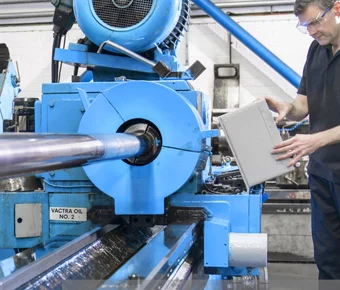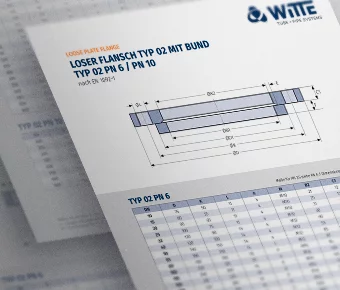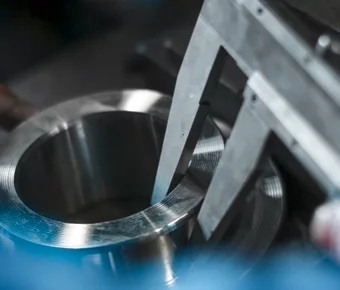Material Data Sheet and Technical Overview
The stainless steel grade 1.4571, also known as X6CrNiMoTi17-12-2, AISI 316Ti or SS 316 Ti, is an austenitic chromium-nickel-molybdenum stainless steel stabilized with titanium. The titanium addition improves resistance to intergranular corrosion by preventing the formation of chromium carbides during long-term exposure to temperatures between 450 and 850 °C. This makes 316Ti stainless steel especially valuable for welded constructions and thermally stressed components.
Standards and Identifications of Stainless Steel 1.4571
● EN: 1.4571
● DIN: X6CrNiMoTi17-12-2
● AISI: 316Ti
● UNS: S31635
Alternative designations include 316Ti material, 1.4571 stainless, EN 1.4571 stainless steel,
and X6CrNiMoTi17-12-2.
Material Profile: Stainless Austenitic Chromium-Nickel Steel
1.4571 / 316Ti is a stainless austenitic chromium-nickel steel with enhanced corrosion resistance, especially against pitting and in aggressive media. It shares core characteristics with standard 316, but thanks to its titanium stabilization, offers:
● Improved resistance to intergranular corrosion after welding
● High resistance to a broad range of organic and inorganic acids, even at elevated concentrations and temperatures
● Reliability in thermal cycling environments, where long-term exposure to medium temperatures is expected
● Similar pitting resistance as 316 (PREN 23.1–26.7), but not suitable for seawater exposure
1.4571 || 316Ti
- Good weldability
- High resistance to general corrosion
- Good resistance to intergranular corrosion
- Good cold formability
- High tensile strength
- Good forgeability
Typical Applications of EN 1.4571 Stainless Steel
The 316Ti stainless steel is frequently used where high corrosion resistance and thermal stability are critical, such as:- Plant and apparatus engineering
- Chemical and petrochemical industry
- Food processing industry
- Pipeline construction
- Mechanical engineering
- Building industry
- Nuclear technology
The 1.4571 material, or AISI 316Ti, is a titanium-stabilized austenitic stainless steel developed for demanding applications involving corrosive media, thermal cycling, and welded constructions. It offers reliable performance in a wide temperature range and shows enhanced resistance to intergranular corrosion compared to non-stabilized steels like 316L.
Thanks to its combination of mechanical and chemical properties, ss 316 Ti is a preferred material in various industrial sectors that require robust and durable stainless steel solutions.
Chemical Composition of 1.4571 Material
(weight proportion in %)
| Value | Proportion % |
|---|---|
| Carbon (C) | min. 0% - max. 0.08 % |
| Manganese (Mn) | min. 0% - max. 2.00 % |
| Silicon (Si) | min. 0% - max. 1.00 % |
| Phosphorus (P) | min. 0% - max. 0.045 % |
| Sulfur (S) | min. 0% - max. 0.030 % |
| Chromium (Cr) | 16.5 – 18.5 % |
| Nickel (Ni) | 10.5 – 13.5 % |
| Molybdenum (Mo) | 2.00 – 2.50 % |
| Titanium (Ti) | 5xC – 0.70 % |
Mechanical Properties at 20 °C
| Hardness (HB) | ≤ 215 |
| Yield strength (Rp₀.₂) | ≥ 200 N/mm² |
| Tensile strength (Rm) | 500 – 700 N/mm² |
| Elongation (A5,65) | ≥ 40 % |
| Elastic modulus | 200 kN/mm² |
Physical Properties of 316Ti Stainless Steel
| Density | 8.0 kg/dm³ |
| Electrical resistance | 0.75 Ω·mm²/m |
| Thermal conductivity | 15 W/m·K |
| Specific heat capacity | 500 J/kg·K |
| Magnetizability | non-magnetic |
Temperature Behavior and Heat Resistance
Stainless steel 1.4571 is designed for operation up to 550 °C and is also suitable for cryogenic conditions. Thanks to the titanium content, it resists carbide precipitation and maintains corrosion resistance even after long-term thermal stress.
| Solution annealing | 1020 – 1120 °C (cooling in water or air) |
| Hot forming | 1200 – 900 °C (cooling in air) |
| Service temperature range | cryogenic to 550 °C |
- Designation according to DIN: X 6 Cr Ni Mo Ti 17
- ASTM Grade: 316 Ti
- EN: 1.4571
- ASME: 316 Ti
- AFNOR: X6CrNiMoTi 17-12-2
- DIN: 1.4571
- SIS: 2350

Tables and rates

Haven’t found the right steel?
We offer you the complete range for stainless steel piping systems, in different materials and for the highest demands.








